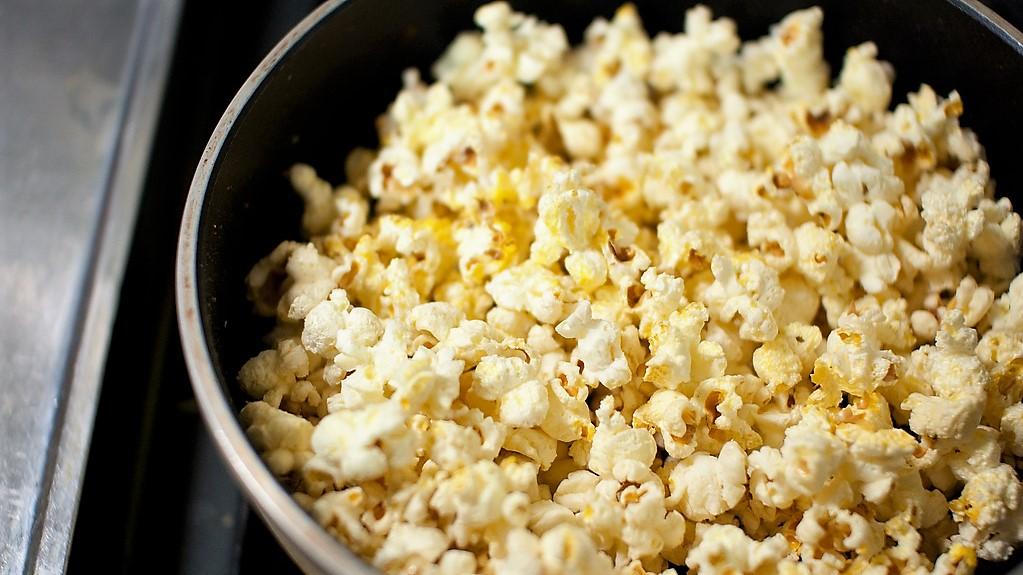We’ve been nuking our food for 50 years now — but how do microwaves even work?
Popcorn is one of the leading causes of fire inside microwave ovens, according to safety expert John Drengenberg.
This year marks 50 years since the first microwave oven entered home kitchens. Called the Radarange, the machine sold for a whopping $495 in 1967, and we’ve been nuking our food ever since — but not without lingering questions about how the appliance even works.
A few of those questions (and concerns) bubbled up in the Science Friday office recently, when the microwave oven malfunctioned. Producer Christie Taylor captured office sentiments about the offending appliance, which had begun turning on instead of off when the door was opened.
“If it’s cooking chicken, is it also cooking my hand if it is on with my hand in it?” asked producer Alexa Lim.
Events and office manager Rachel Bouton was thinking longer term: “I always wonder if all the microwave food I eat is going to give me cancer the same way everything else is eventually going to give me cancer?”
And podcast producer Elah Feder, from left field: “I’ve seen insects get microwaved and seem fine. How does that work?”
So, on a recent show, the Science Friday team assembled experts to answer the questions many of us may have about microwave ovens. As it turns out, the Radarange was aptly named — the appliances actually use the same technology as radar.
Timothy Jorgensen, an associate professor of radiation medicine at Georgetown University, explains that microwave ovens were invented by a Raytheon employee named Percy Spencer, who was working on radar technology for the government.
“One day, he was working with an item called a magnetron, which is what actually produces the radar waves,” Jorgensen says. “And so the thing was on, and he noticed that a candy bar he had in his pocket was melting, and so he attributed it, it must be coming from the microwaves.”
Then Spencer aimed the magnetron at an egg, causing it to explode, Jorgensen says. He tried the same thing with popcorn. “And pretty soon, he went on to patent that and it became the microwave oven.”
The first microwave ovens were the size of refrigerators, according to John Drengenberg, consumer safety director at Underwriters Laboratories, a safety science company that’s been testing microwave ovens since their inception. “And in fact, to keep the magnetron … cool, they had to plumb it with cold water.”
Our slim, modern microwave ovens still heat food using magnetrons, but the radiation they produce isn’t as high-energy as the radiation used in X-rays or cancer treatments. As Jorgensen explains, “the whole world of radiation” can be divided into two groups: nonionizing radiation types like microwaves, radio waves and cell phone radiation; and ionizing radiation types like X-rays and gamma rays.
Ionizing radiation forms “have wavelengths so short that they can actually rip electrons off of atoms and cause damage,” he says. “And it’s those things we worry about, the ionizing radiations.” In contrast, nonionizing radiation types “do not damage chemicals,” he adds. “They heat them up, but they don’t damage them.”
Microwaves heat our food by agitating water molecules inside of it (which is why our moistureless cooking vessels don’t get as warm.) They could theoretically do the same to our bodies, but as Jorgensen clarifies, there’s protective mesh embedded in the oven door to trap the waves inside. “You can see through the holes what’s going on in the oven, but the waves are not actually coming out and cooking you. That’s how it works.”
But in a plug for cleanliness, Drengenberg advises keeping the oven interior clean, and wiping up any spills that could interfere with the seal on the door. “If it gets to be a crusty mess there, it could allow microwave energy to escape. So, keep that door gasket area very clean with a damp rag. That’s the best safety device that you could have, is a damp cloth.”
Drengenberg would know — one test at Underwriters Laboratories measures how well microwave ovens contain fires. “Very often, we’re in such a hurry, we push all the wrong buttons on the microwave oven and then run away from it. Nobody wants to sit there and watch the food cook,” he says.
The leading causes of fire inside microwaves are popcorn and potatoes, he says. And so to combat future kitchen fire calamities, Underwriters Laboratories devised a test: “We put potatoes inside a microwave oven on the turntable, a number of potatoes,” Drengenberg says. Then, they cover the microwave with a cheesecloth and nuke the spuds.
“We heat them until they get very dry, they turn black, and ultimately little sparks appear across the peel and they burst into flame. And then you’ve got a flaming merry-go-round inside.” If the fire spreads at all to the cheesecloth on the outside, “it’s a failure,” he says. “If it doesn’t, it’s OK.”
As for the failing “Science Friday” appliance, the experts are unanimous: “The first thing I would recommend is to get rid of the oven,” Jorgensen says.
“I agree completely, I agree completely,” Drengenberg says. “Throw that away.”
This article is based on an interview that aired on PRI's Science Friday.
